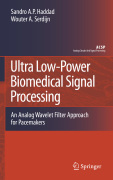
Ultra low-power biomedical signal processing: an analog wavelet filter approach for pacemakers
Haddad, S.A.
Serdijn, W.A.
Often WT systems employ the discrete wavelet transform, implemented on a digital signal processor. However, in ultra low-power applications such as biomedical implantable devices, it is not suitable to implement the WT by means of digital circuitry due to the relatively high power consumption associated with the required A/D converter. Low-power analog realization of the wavelet transform enables its application in vivo, e.g. in pacemakers, where the wavelet transform provides a means to extremely reliable cardiac signal detection. In Ultra Low-Power Biomedical Signal Processing we present a novel method for implementing signal processing based on WT in an analog way. The methodology presented focuses on the development of ultra low-power analog integrated circuits that implement the required signal processing, taking into account the limitations imposed by an implantable device. Offers a structured approach to filter design, starting from an arbitrary transfer function or impulse response, all theway down to the actual circuit design Concentrates on low-power design at allthe hierarchical design levels involved, viz. of the transfer function, of the topology and of the circuit; at all levels the results are verified and put into perspective INDICE: From the contents 1 Introduction. 2 The Evolution of Pacemakers: An Electronics Perspective. 3 Wavelet versus Fourier analysis. 4 Analog Waveletfilters: the need for approximation. 5 Optimal State Space Descriptions. 6 Ultra Low-power Integrator Designs. 7 Ultra Low-power Biomedical System Designs.8 Conclusions and Future Research. A High-Performance Analog Delays. B Model reduction - the Balanced Truncation method. C Switched-Capacitor Wavelet Filters. D Ultra-Wideband Circuit Designs. Summary.
- ISBN: 978-1-4020-9072-1
- Editorial: Springer
- Encuadernacion: Cartoné
- Páginas: 250
- Fecha Publicación: 01/12/2008
- Nº Volúmenes: 1
- Idioma: Inglés
